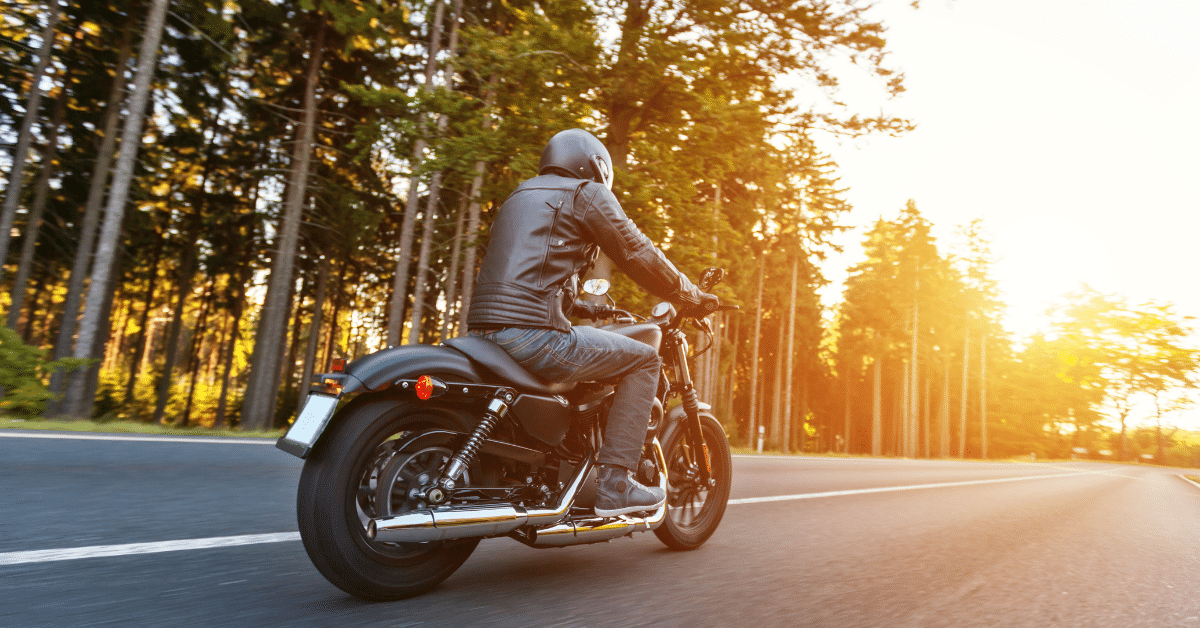
There is no avoiding the fact that riding a motorcycle can be dangerous. Better understanding how, when, and why accidents happen can help you take better precautions to keep yourself safe. Let’s take a look at ten motorcycle accident statistics from the National Highway Traffic Safety Administration’s 2020 Fact Sheet that you should know.
1. Motorcycle Drivers Are More Likely to Have a Fatal Accident than Car Passengers
Based on miles traveled per vehicle in 2019, motorcycle riders and passengers were nearly 30 times more likely to die in an accident than people driving and riding in cars. Their injury likelihood also quadrupled that of car accidents.
During that year, approximately 25% of motorcyclists died in accidents compared to only a 1.5% mortality rate in cars.
2. Most Fatal Accidents Occur in Broad Daylight
You might assume that most accidents, motorcycles or cars, happen at night with low visibility. However, the most common time of day that fatal motorcycle accidents occur is between 3 p.m. and 6 p.m. on weekdays and 6 p.m. to 9 p.m. on weekends.
Traffic is busier and more congested at those times, which can lead to more dangerous driving conditions. Of course, you can’t always avoid driving at certain times, but it’s important to remain vigilant when riding your motorcycle in heavy traffic.
3. Speed Is Not the Most Common Cause of Fatal Accidents
Too many people think that motorcycles are only dangerous when driven by a reckless driver who speeds. However, only one in three fatal motorcycle accidents occurs from speeding.
While it may not be the most common cause, speeding is still a concern. Not only does speeding affect the driver’s chance of survival, but it can also harm others on the road.
4. What Are the Common Causes of Motorcycle Accidents?
So if it’s not always about speeding, what are some of the other leading causes for motorcycle crashes?
- Two- and three-vehicle crashes. More than 50% of fatal motorcycle accidents involve two or more vehicles, meaning you should stay just as aware of those around you as you are of yourself.
- Single bike crashes. Just beneath that, nearly 40% of fatal accidents happen with only one bike, often hitting a stationary object or running off the road.
- Left-turn crashes. Both motorcycles and cars are at their highest risk when turning left. This scenario leads to the most accidents for any vehicle out of all traffic maneuvers.
- Riding without a license. One in every three motorcycle riders that die in an accident does not have a driver’s license.
- Riding with a smaller engine. Often, bikers choose lighter motorcycles with smaller engines for many reasons. But nearly half of fatal crashes come from drivers with bikes that have between a 500cc and 1,000cc engine.
5. Motorcycle Helmets Reduce Head Injuries and the Fatality Rate
Motorcycle helmets are required by the Highway Traffic Safety Administration in many states for a reason. They have been proven to prevent fatal injuries in 37% of motorcycle accidents and can prevent brain injury in 67% of accidents.
One in every three fatal crash victims could have survived if they had worn a helmet. In 2017, helmets saved 1,872 motorcyclists’ lives.
However, only 20 states enforce the universal helmet law. Some states require helmets under the age of 18, and some do not require them at all. Because of this, less than half of riders around the country wear a helmet.
Regardless of the law where you live, it is strongly advised to always wear a helmet when riding.
6. Warmer States Have a Higher Fatality Rate
It may not be a surprise that there are more bikes in milder weather. But because of this, these places have higher motorcycle crash mortality rates. According to the NHTSA, the top states in the country with the highest fatality rates are:
- Florida
- California
- Texas
- Pennsylvania
- Ohio
7. The Average Age for Motorcycle Fatalities Is Over 40
Another assumption many people make is that most accidents involve young, reckless, and inexperienced drivers. However, in 2020, 2,977 motorcyclists ages 40 and up were killed in a traffic accident, compared to 2,717 fatalities under the age of 40. The most common age to die in a motorcycle accident is 43.
The reason for this could be the decreased vision, hearing, and body strength that come with older age. It could also be due to worsened balance or slower reflexes. Regardless, it is important to feel confident in your physical abilities before getting on a bike.
8. In 2020, 76% of Fatal Motorcycle Accidents Involved Front Collisions
According to the National Highway Traffic Safety Administration’s 2020 Traffic Safety Facts, in two-vehicle crashes, 76 percent of motorcycles involved in fatal crashes where struck from the front. Only 7 percent were struck from the rear.
9. The Number of Fatal Accidents Continues to Increase
In 2020, fatal motorcycle crashes in the United States increased by 11 percent from 2019, rising from 5,044 to 5,579. In 2020, according to the NHTSA, there were 5,579 motorcyclists killed, 14 percent of all traffic fatalities.
10. Hiring a Motorcycle Lawyer can Increase Compensation
Studies show that drivers who hired a lawyer saw a 40% increase in compensation and insurance settlements when involved in any motorcycle accident.
Drive Safe and Drive Smart
Understanding these motorcycle accident statistics can help you better prepare to drive safely. Small precautions like wearing a helmet and following the speed limit can save your life.
If you’ve been in a motorcycle accident, call the Law Tigers motorcycle accident lawyers at 1-888-863-7216. Our team of experienced attorneys will fight for your rights and pursue fair compensation. Schedule your free case evaluation today!



